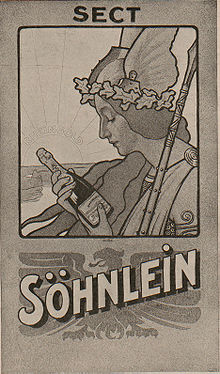Youth (magazine)
| Jugend - Munich illustrated weekly for art and life |
|
|---|---|
| description | German art and literature magazine |
| language | German |
| publishing company | Georg Hirth, Munich |
| First edition | 1896 |
| attitude | 1940 |
| Frequency of publication | weekly |
| Editor-in-chief | Hans E. Hirsch, Theodor Riegler, and Wolfgang Petzet |
| editor | Georg Hirth, Franz Schoenberner |
| Web link | [1] |
| ZDB | 501389-6 |
Jugend - Münchner Illustrierte Wochenschrift für Kunst und Leben was an art and literary magazine founded by Georg Hirth and Fritz von Ostini , which appeared in Munich from 1896 to 1940.
history
The youth became the namesake of the Art Nouveau style , which shows how important the magazine was for the style-historical debate of early modernism in Germany. Nevertheless, the content and orientation of the youth cannot be reduced to the label "Art Nouveau" even in their heyday. In addition to modern illustrations and ornaments of Art Nouveau , other styles also played a role, above all impressionism . The Scholle artists shaped the magazine's artistic appearance well into the 1920s.
The magazine was also satirical and culturally critical. The main targets of the attack were the “muckertum” (keywords anti-modernist oath , Lex Heinze ), the influence of the churches, especially the Catholic ones (keyword ultramontanism ), and especially the political right in the center party . In addition, the magazine supported progressive currents that were typical of the Empire in the Wilhelmine era, such as the Bund für Mutterschutz .
The contribution made by young people to the literature of early modernism, on the other hand, remained modest - in stark contrast to the competing company Simplicissimus from the Albert Langen publishing house, also founded in 1896 .
After Hirth's death in 1916, Franz Schoenberner became editor. The editors-in-chief included Hans E. Hirsch, Theodor Riegler and Wolfgang Petzet. In addition to the text editors, z. B. Fritz von Ostini or Albert Matthäi , worked u. a. the picture editor Franz Langheinrich .
From the First World War , the youth increasingly became a German national and Bavarian homeland magazine; there had already been a tendency towards this in the early years. From the mid-1920s, the magazine was opened again to artists of the younger generation, including George Grosz , and printed texts by Kurt Tucholsky and Erich Kästner .
After 1933, the magazine adapted to the völkisch line of the National Socialists . Nevertheless, it was discontinued in 1940.
Artist

Not all of the image material found among young people was specifically produced for the magazine. So there are z. B. “Purchases” of pictures by the “ painter princes ” Böcklin , Lenbach and Kaulbach or from Thomas Theodor Heine and Giovanni Segantini . On behalf of the youth , among others, painted and drew:
Authors
Among other things, wrote for the youth:
literature
- Laurence Danguy, L'ange de la jeunesse. La revue Jugend et le Jugendstil à Munich , Paris, Maison des sciences de l'homme, 2009, ISBN 978-2-7351-1211-1
- Bernd Dürr: Leo Putz, Max Feldbauer and the circle of “ Scholle ” and “youth” in Dachau around 1900 . Dachau 1989.
- Microfiche edition
- Heinz Spielmann : YOUTH - Aspects of a weekly , Harenberg, Dortmund 1988, ISBN 3-88379-545-3
Web links
- www.jugend-wochenschrift.de - Project of the Duchess Anna Amalia Library Weimar (with indexing database)
- Jugend - Munich illustrated weekly for art and life - digital from Heidelberg University Library
- Youth Magazine - (English)
- List of contributors »Youth« Vol. 1-25
Individual evidence
- ↑ Simplicissimus · the historical satirical magazine · homepage. Retrieved August 28, 2019 .
- ↑ ZB Georg Hirth, Karlchen, Mutter und Daughter, in: Jugend 13/4 (1908), p. 95, also in issue 13 / (1908), p. 169.



